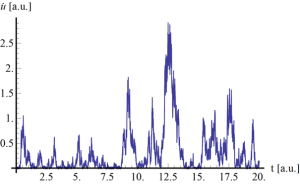Extreme value statistics is becoming a popular and well-studied field. Just like the sums of random variables exhibit universality described by the central limit theorem, maxima of random variables also obey a universal distribution, the generalized extreme-value distribution. This is interesting for studying e.g. extreme events in finance (see this paper by McNeil and Frey) and climate statistics (see e.g. this physics paper in Science and this climatology paper).
Having refereed a related paper recently, I’d like to share some insights on the statistics of extreme avalanches in disordered systems. An example are particularly large jumps of the fracture front when slowly breaking a disordered solid. A simple but reasonable model for such avalanches is the Alessandro-Beatrice-Bertotti-Montorsi (ABBM) model, originally invented for describing Barkhausen noise. I already touched upon it in a previous blog post, and will focus on it again in the following.
I’ll show an exact formula for the distribution of the maximum avalanche size in an interval, and connect this result to the universal extreme value distribution when considering a large number of avalanches.
